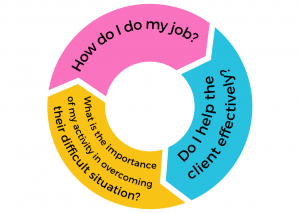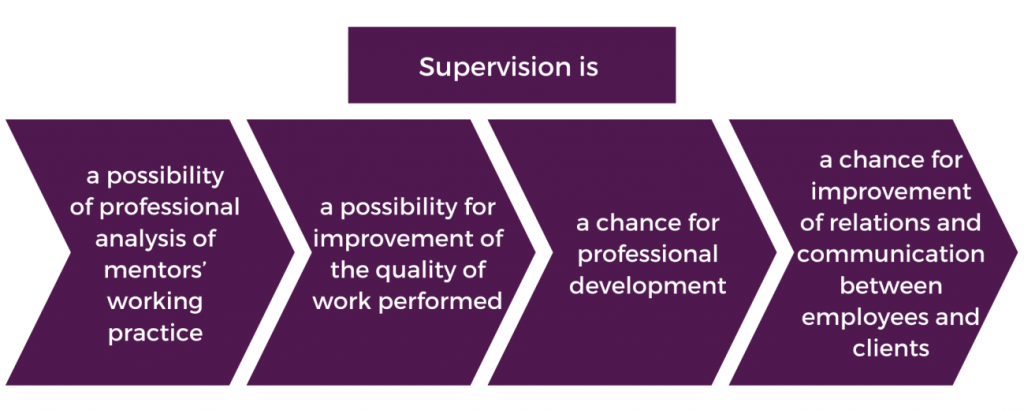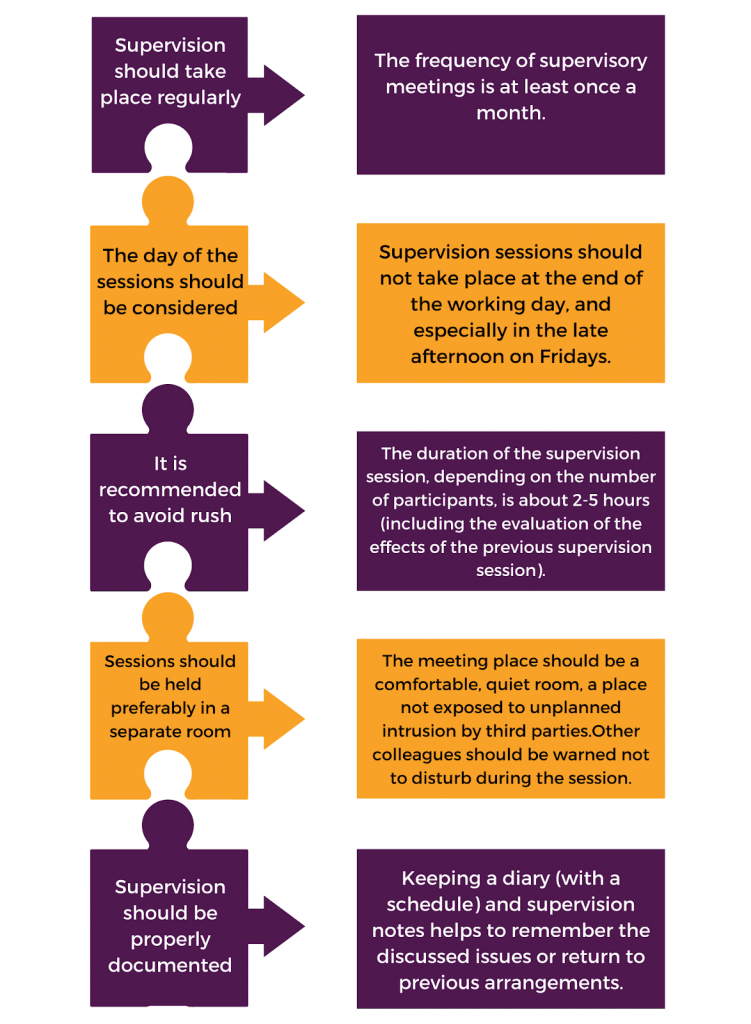Module 6
SUPERVISION
Introduction
Migrant women are exposed to greater risk when they make the decision to migrate to a completely different country and have to face a new integration process.
For this reason, the support of formal and institutional networks as well as peer support programmes are necessary to help these women in their integration process.
This module provides information on what supervision is and how mentors can benefit from this kind of support. We describe how to efficiently and effectively conduct supervision and prepare mentors for it. This module will also contribute to knowing how to determine if peer support is successful.
Our aim is to help organizations and mentors to support and encourage migrant women to deliver further peer support. This module will be very useful for organizations working with migrant women and helping them to build a support network within the community.
Objectives
- To become familiar with planning supervision activities,
- To expand knowledge of the benefits from supervision,
- To find out the role of supervisors, mentors/supervisees and migrant women,
- To define in general terms how supervision works,
- Greater ability to determine if peer support is successful,
- Deeper understanding of the importance of supervision.
Duration & Requirements
Approximate reading time for the module, without taking suggested resources and further reading into consideration, is about 2 hours.
The learners don’t need to have any particular knowledge or skills. The learners will need a computer with an internet connection and sheet of paper and a pen to take notes.
It is advisable that the learners have an insight into the reference material and thus deepen their knowledge with the information provided.
Content

Supervision is provided for the mentors – employees of the organization, which is to serve the professional development of them and improve the results of their work. A diligently conducted supervision, with the involvement of the supervised person, helps to objectively evaluate one’s actions, look at their own behavior from a distance, answer the questions.
This objective view in turn helps in spotting cause-effect relationships and discovering mistakes that need to be corrected in order to become an “effective helper” – mentor and peer supporter.
Supervision also serves the person managing the organization – it helps maintain mentors’ pursuit of the organization’s goals, helps to comply with regulations, helps to maintain professional standards and norms, and maintains good employee relations. So its role is huge.
What is supervision?
Supervision is a special, multifaceted overseeing of somebody’s work, guiding it at the same time, aimed at solving difficulties and improving the mechanisms related to the performance of a given task. It is a process that helps to increase awareness, develop skills, achieve better results, act through honest assessment, discussion of problems, targeted practice and feedback. The condition for the success of the supervision is the consent of its participants to share their experiences in working with migrant women and to analyze it.
We distinguish:
- individual supervision – conducted with one person based on her/his experience,
- group supervision – directed to a team, a group where the experiences of all people are combined and group members exchange their observations.
What is the purpose of supervision?
The aim of the supervision is to improve the quality of work of people, and thus also organizations, working with migrant women and implementing a peer support programmes, to increase the effectiveness of work with migrant women and peer support programmes, and thus - to improve the well-being of migrant women, quality of peer support programmes and increase job satisfaction.
Each supervision – regardless of whether it will be individual or group – is part of the training and professional development of mentors. In this sense, its goal is to update the mentor's knowledge and professional skills, overcome professional problems and help overcome psychological barriers at work.
Moreover, supervision increases the efficiency of the organization and helps to coordinate the work of mentors and achieve the organization's goals. It introduces and maintains good work standards, ensures organizational effectiveness, coordinates the activities of employees and their cooperation with other centers, non-governmental organizations and all kinds of institutions, and above all with the recipients of activities.
What does supervision give mentors? What are its benefits?
Mentors can benefit from supervision in many ways. What is more, it is not only beneficial for mentors, but also for organizations they are working for and migrant women themselves.

Thanks to evaluation of one’s work it might make people aware of the sources of problems and introduce changes.
Main benefits of supervision for mentors are:
- Analysis of the mentor's own work with migrant women – individually with a supervisor (individual supervision) or in a group of other specialists / mentors (group supervision),
- Developing an organized plan of work with migrant women, using the experience of the supervisor or other session participants,
- Broader insight into one's own work-related emotions, experiences, reflections and their constructive use in further peer support,
- Support from the supervisor or a group of specialists / mentors performing similar tasks, working in a similar environment and with a similar group of recipients, interested in self-development,
- Learning new solutions, methods, good practices, positive patterns of working with migrant women,
- Talking and explaining one's own dilemmas that arise in working with migrant women,
- Focus on the target group, its problems, needs, support and solutions.
For organizations in particular, supervision can be a tool of presenting an organization's priority tasks and controlling the implementation of the statutory objectives of the organization. It might be used for verification of compliance of mentors’ actions with the applicable procedures and regulations. Moreover, it can be useful for indication of e.g. gaps in knowledge, lack of training, lack of regular staff meetings, but also organizational shortcomings.
What can discourage mentors from participating?
There are many apprehensions that might discourage mentors from participating in the supervision process. Their willingness, openness and readiness depends on how the process is introduced to them and organized.
Main difficulties related to participation in supervision:

- Ignorance of what supervision is and how it works, and thus low willingness to talk about problems;
- Anxiety related to the review and evaluation of work by the supervisor and other mentors participating;
- Fear of assessment (critical, negative), and thus presenting the situation in the best light by mentors;
- Fear of influencing one’s work by others and thus hiding real problems;
- Fear of having to make changes in working with clients, which not everyone is ready for;
- Shame about having low competences or a lack of certain skills or experience;
- Fear of deeper insight into one's own emotions;
- Bad past experiences.
It is on the side of the organization to properly prepare their employees, mentors for the supervision process. Below we will tell more about some tips for organizing the supervision process satisfactorily.
Tips for organizing the supervision process
All general principles of supervision should be adapted to the context of the organization intending to use supervision in its work. At the beginning, it is worth discussing the principles and agreeing on the needs and goals of the mentor's supervision.
How to determine if peer support is successful?
Migrant women are exposed to greater risk when they make the decision to migrate to a completely different country and have to face a new integration process. For this reason, the support of formal and institutional networks as well as peer support programmes are necessary to help these women in their integration process.
Once the peer support activity is organized and being implemented, it is not certain that things will go as they were planned. A successful peer support requires good management and continuous supervision. This focuses on mentors and supervisor’s analysis and problem solving. They will be given suggestions, tips and tools to manage their work and peer support given to migrant women. Properly designed and systematically implemented supervision process can help strengthen and sustain peer support activities. Although, the key is to continually change or revise one’s approaches based on the needs of migrant women and characteristics of their and organization’s environments. Continuous supervision applies to all peer support programmes and all mentors engaged.
What elements and activities good peer support programme should have?
There is no single factor that guarantees if peer support is or will be successful, but some elements often determine success in peer support programmes. These are:
- Considering migrant women’s personal, social, economical and cultural characteristics and needs,
- Creation of safe and supportive environment,
- Creation of space to use migrant women’s shared experiences,
- Maintaining frequent contact with migrant women (long-term and ongoing support),
- Conducting analysis of individual and common problems and searching for possible solutions,
- Establishing mutual support and good relationships,
- Reach-out and engagement of programme participants,
- Retention and limited turnover of migrant women as well as mentors,
- Considering migrant women’s individual rights, privacy and the limits of mentor’s role.
Moreover, there are some activities which good peer support programme should have to empower and develop migrant women’s potential:
- Boosting migrant women’s self-confidence and increasing communication skills,
- Development of problem-solving and decision-making skills,
- Development of greater flexibility and adaptability to changes in society and labor market,
- Collaboration and sharing knowledge and competences between migrant women themselves and mentors,
- Enabling to understand how peer support is delivered and what is the impact of the programme,
- Development of greater acquisition of knowledge and self-reflection,
- Increasing awareness of peer support and programmes participation benefits.
Depending on the main goals of the given peer support activity, factors and elements that determine if peer support is or will be successful may vary. Mentors can apply different methods to address migrant women’s day-to-day challenges and also supervisors can evaluate those components with a different scale.
Mentors should exploit dynamics existing within a peer support group, and thus be able to reach the highest number of migrant women possible in order to generate real change. If the peer support is done well, migrant women can become awareness Ambassadors in the given topic through encouraging community members to reflect on the importance of sharing knowledge and experience with their peers. This will allow migrants to be incorporated into the social, economic, cultural and political life of the receiving community.
How to evaluate peer support?
Ongoing monitoring, supervision and evaluation are core components of peer support programmes. Evaluating peer support is important for designing peer support programmes, understanding what peer support looks like and demonstrating programme impact. Knowing “when, how and what to evaluate” is very important. In many cases, answers to these questions can be critical to programme sustainability.
In general, programme evaluation starts with planning to make sure what you are going to measure. It answers not only the question of “did peer support work”, but also “how it worked”. Overall, it is crucial to identify reliable measures, indicators, tools and instruments that are relevant to overall programme goals, objectives and activities.
Planning an evaluation can be done with the RE-AIM Model. This evaluation framework (outlined below) includes and goes beyond a sole focus on the “did it work?” question to help expand our understanding of and translate effective peer support.
According to RE-AIM, evaluations should examine five dimensions:
- Reach the target groups
- Effectiveness or efficacy of the intervention/programme
- Adoption by target groups, communities or organizations
- Implementation consistency of delivery of intervention/programme
- Maintenance of intervention/programme effects in individuals and communities over time.
This tool can be used to evaluate peer support and to determine if peer support is successful. Answering those detailed question will help to plan activities, notice weaker sides and introduce needed changes.
KEY QUESTIONS | PROBES AND FOLLOW-UP QUESTIONS |
REACH | |
Dimension or Issue: Who will take part? | |
Who will the initiative appeal to? (End-users of the initiative) | Whom do you plan to reach in your initiative? ............................................................................................................... Define the intended beneficiaries (target group(s). ............................................................................................................... |
How and where will you reach them? | How will you advertise and promote the programme? ............................................................................................................... Who needs to approve these methods? ............................................................................................................... How will know if you reached them and who participated? ............................................................................................................... |
How will you know if those who participated are representative of the intended target group? | What methods will you use to attract underserved groups and focus on inequities? ............................................................................................................... What information is available to determine that the sample is representative of the target audience? ............................................................................................................... |
EFFECTIVENESS | |
Dimension or Issue: What results? | |
What are the most important outcomes you expect to see? (e.g., more social activity, better/improved quality of life, less exclusion, etc.) | What is the targeted individual-level change? ............................................................................................................... How will you measure these changes? ............................................................................................................... Who will care about the outcomes? ............................................................................................................... How will you share these outcomes? ............................................................................................................... |
How likely is it that your initiative will achieve its key outcomes? | What are the biggest threats to seeing the outcomes you want? ............................................................................................................... |
Will your programme be effective for those most in need? | How will your programme need to be adapted to benefit these individuals? ............................................................................................................... |
What unintended consequences or outcomes might there be? | What has gone wrong in other similar initiatives? ............................................................................................................... |
ADOPTION | |
Dimension or Issue: Where will initiative be conducted? | |
What settings or organizational types are you targeting (e.g., schools, workplaces, community settings or organizations)? | What are key characteristics of the settings you want to participate? ............................................................................................................... Who might be interested in this initiative and Why? ............................................................................................................... How will settings hear about this? ............................................................................................................... What were characteristics of settings that did not participate (e.g., location, facilities, finances, personnel)? ............................................................................................................... |
How many of these settings and organizations (or individual people) do you estimate will use the programme? | What external or environmental supports or threats are there? ............................................................................................................... How will you know if organizations/individuals used the initiative? Who can help gather information about this? ............................................................................................................... |
Who will deliver the programme (actually do the work) and do they have the skills and time? | What are the expertise or characteristics of those (e.g. staff, volunteers) you are wanting to deliver the intervention/programme? ............................................................................................................... |
How many of these persons (staff or volunteers) do you estimate will use the programme? | What characteristics may differ from the invited staff and those who participate (e.g. education, time in position, training, capacity)? ............................................................................................................... |
IMPLEMENTATION | |
Dimension or Issue: How consistently will you deliver the programme? | |
How will the initiative be delivered, including adjustments and adaptations? | What are the key elements of the initiative that must be delivered to be successful? ............................................................................................................... |
To what extent will the key aspects of the programme be delivered as intended? | How will you assess programme delivery (self-report, audit, checklists)? ............................................................................................................... Describe the feasibility of these methods. ............................................................................................................... |
What adaptations or modifications do you think will be necessary to help implement the initiative to fit your different settings? | What are likely implementation challenges you will need to overcome? ............................................................................................................... |
How will you know what adaptations or modifications were made during the programme? | Who can help you keep track of modifications or adjustments made? ............................................................................................................... |
What are some of the possible obstacles to consistent implementation? | Are there competing projects or programmes to consider? ............................................................................................................... |
What costs and resources (including time and burden, not just money) need to be considered? | Are these costs and resources available and reasonable to ask for (high enough priority?) ............................................................................................................... |
Maintenance/Sustainability | |
Dimension or Issue: When will your initiative need to be renewed? | |
What will happen over the long-term? Consider for both Individual beneficiaries and Settings | What are likely implementation challenges you will need to overcome? ............................................................................................................... |
Can ORGANIZATIONS sustain the initiative over time and are there plans to leave trained staff in place? | What infrastructure supports will be needed to sustain the initiative? ............................................................................................................... Is there an infrastructure and funding that will remain? ............................................................................................................... How will this initiative align with current and future policies and reimbursement; revenue streams? ............................................................................................................... |
How likely is your initiative to produce lasting effects for INDIVIDUAL PARTICIPANTS? | How will individuals be delivered key programme components over time? Will they stay in contact? ............................................................................................................... |
How will you be able to follow your initiative for an extended period of time? | How will you continue to track success and provide ongoing feedback? “How’s it working for you?” ............................................................................................................... |
How will you get the word out about your product and lessons learned? | What easy to understand materials can you produce to tell others about your lessons learned? ............................................................................................................... |
What are likely modifications or adaptations that will need to be made to sustain the initiative over time (e.g. reduced intensity, different staff, different settings)? | How can you track the major changes made over time? ............................................................................................................... |
Summary
In this module, we provide some information on how to plan a successful supervision process for mentors and how to determine if peer support is successful. It gives an overview of the importance of supervision and benefits of its implementation. Within this module you will find out the role of supervisors and supervisees, and define in general terms how supervision works. Moreover, you will develop greater ability to determine if peer support is successful and become familiar with planning supervision activities to systematically evaluate it. This module will be very useful for organizations working with migrant women and helping them to build a support network within the community.
Learning Outcomes
By the end of this module you will be able to:
- Plan a supervision process,
- Explain what are the benefits from supervision,
- Define in general terms how supervision works,
- Recognise the role of supervisors, mentors/supervisees and migrant women,
- Know how to determine if peer support is successful,
- Understand the importance of supervision.
Self-assessment
Suggested resources
- Kieran O’Donoghue, Restorying Social Work Supervision (https://www.academia.edu/16048958/Restorying_Social_Work_Supervision)
- Kieran O'Donoghue, Lambert Engelbrecht, The Routledge International Handbook of Social Work Supervision
References
- Carter McNamara, What is Supervision? How Do I Supervise? (https://managementhelp.org/supervision/index.htm)
- https://edukacjaustawicznadoroslych.eu/images/2017/4/14_4_2017.pdf
- http://www.poradnictwo.org.pl/superwizja-pracy-socjalnej/
- https://pomocspoleczna24.pl/nr-5-kwiecien-2018/superwizja-niezbedny-element-poprawy-jakosci-pracy-pracownika-socjalnego-132.html
- https://epale.ec.europa.eu/pl/blog/superwizja-uczestniczaca-nadzor-czy-wsparcie-rozwoju?fbclid=IwAR1cXaERssPvWkZkQX48paVEtH0Ll_uECsLcwI0LMt3Z_07Af3lvxJqou7U
- http://peersforprogress.org/take-action/evaluate-peer-support/
- https://re-aim.org/
